BSB Cod.icon. 265
Flemish chorography in portraits of sovereigns, the arms of nobles, and the lands in its geography
the Netherlands, 1562
Click button marked "Miniaturansicht" above any page to view thumbnails five at a time.


I spend a fair amount of time "flipping through" electronic texts, reviewing heraldic emblazons from the 16th century and before or searching them for examples of particular charges, arrangements, etc. I've decided I could benefit from a reference that would lead me to emblazons of a particular style or remind me what the contents of a given book are, so that I can spend more time looking at what interests me and less looking for what interests me. This page is my answer to that need. Its contents and organization reflect my interests and the way I best remember and retrieve information; it may not fit anyone else's quite as well. But if it is helpful to you, I hope you'll use it.
I'm grouping the texts by region and/or subject as I go. Thus far, I have:
| Manuscript Number and Description | Notes | Representative Pages |
|---|---|---|
|
BSB Cod.icon. 265 Flemish chorography in portraits of sovereigns, the arms of nobles, and the lands in its geography the Netherlands, 1562 Click button marked "Miniaturansicht" above any page to view thumbnails five at a time. |
Most pages from folio 2v through folio 42v have a ring above which a single small escutcheon appears. Some of the rings contain portraits and a few have two or more escutcheons or escutcheons with crowns and livery collars. The real armorial starts on 44v. That page of it features some crowned shields and a couple of shields pendant from crested helms; the rest of it has only small, simple escutcheons. There's a map at the very end of the book. |
  |
| Manuscript Number and Description | Notes | Representative Pages |
|---|---|---|
|
BSB Cod.icon. 290 arms of the counts, vicounts, etc. of Cataluna, Castille, and Portugal Spain, 15th-16th century Click button marked "Miniaturansicht" above any page to view thumbnails five at a time. |
This volume has arms in several distinct styles. It may contain pages that were originally part of a number of different documents. From folio 1r to folio 45r, the achievements include a helm with a small crest and feathery mantling. From 46r, to 118r, the shields are larger with rounder bottoms (except for folios 47r and 76r, which have more elaborate shields with crests and mantling), and most have coronets of various types on top. Those on folios 48r and 62r also have flags along their bottom curves, and those on 67r, 69r, and 112r and 113r have small helms with crests and mantling instead of coronets. There's one more eleaborate shield with helm, crest, and mantling on 119r. Each folio from 120r through 151r shows a shield hanging by a strap from a large helm with a small crest and extensive mantling. A half-dozen escutcheons of miscellaneous styles, one with a helm and mantling, start on folio 152v. Then there are a few blank pages and pages with only text. Folios 159v through 167r host a series of simple escutcheons of unusual shape. Folios 168r through 173r have more basic round-bottomed escutcheons, still without accompanying achievements. There are a few blank folios, then on 174v and 175r is the first group of multiple arms together on the page, some of which are topped with coronets. It's followed by another of the unusually-shaped shields, then a second group of shields that stretches across two pages. |
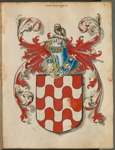 
 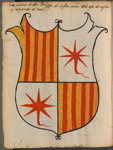
 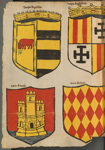 |
| Manuscript Number and Description | Notes | Representative Pages |
|---|---|---|
|
BSB Cod.icon. 291 English arms England, middle of the 16th century Click button marked "Miniaturansicht" above any page to view thumbnails five at a time. |
The armorial begins on folio 2r with the achievement of the King of England, which includes supporters and a motto and is surrounded by four separate royal badges. Below that are two achievements, with supporters, showing the king's arms impaled with those of Catherine of Aragon and Anne Boleyn, respectively. The next page shows four more achievements with supporters, showing the kings arms impaled with those of each of the other four wives of Henry VIII in turn. Each of the folios 3r through 14v shows six achievements with helms and mantling neatly arranged just on top of the escutcheons. Almost all of them have crests. On the first eight of those pages, most achievements include supporters and about half of the escutcheons are encircled by the blue garter of the Order of the Garter. There are another three pairs of supporters on the second and third pages after that, then no more in the book. Starting on folio 15r, the arms are grouped twelve on a page. They still have helms and just-on-top mantling. The first two-and-one-third pages have mitres for crests. Some of the rest have more usual crests, but the majority have none. There are quite a number of blank pages at the end of the book, but none before that. |
  |
| Manuscript Number and Description | Notes | Representative Pages |
|---|---|---|
|
SGS Cod. Sang. 1084 armorial made by Hans Haggenberg for Ulrich Rösch, abbot of Saint Gall's, in the 15th century Select "3x4" on the "View" pull-down menu to view thumbnails twelve at a time. |
The first arms in the book appera on page 1, the last on 337. There are a couple of individual blank pages in the book, but no large block of them before the end of the emblazons. The bulk of the book has achievements with straight-sided, round-bottomed escutcheons, helms, crests, and mantling, appearing two [pages 54 and 55, 120 and 121, 142 and 143, 176 and 177, 180 through 189, 194 through 205, 324, 328, and 329], four [pages 56 through 81, 122 through 141, 190 through 193, 330 through 337] or six [pages 84 through 115, 148 through 171, 206 and 207, 244 through 296, and 300 through 323] to a page. There are several other arrangements that appear on multiple pages. Pages 1 and 4 each show an armed and armored figure lying on the grown with a stylized tree growing out of it. Roughly two dozen shields, each with a letter written next to it, hang from the branches. On pages 2 and 3 the same letters are associated with rectangles on which names are written, and a single crested helm is drawn at the bottom of each. On each page 9 through 13 four pairs of escutcheons, each topped by a single mitre, appear. Pages 17 through 21 each have six large simple escutcheons. Pages 23, 42 through 53, 82, 83, 174, 178 , 208, and 209 each feature a large central achievement surrounded by smaller escutcheons; the numbers and arrangements of small escutcheons and the elements included in the achievements vary. Pages 25 through 35 and 173 have small escutcheons, up to twelve to a page. And pages 210, through 239 have achievements with helms, crests, mantling, and escutcheons of a different shape than those in most of the book presented one to a page. There are also several things that appear only once in the book. Page 14 has a single unpainted achievement, with helm, crest, and mantling. Page 15 has a tower from which two flags (for King David and King Solomon) fly. A dozen small and one larger escutcheon are on it, two more ones bracketing it. Page 16 has three large crowned escutcheons, each associated with a heraldic flag. Page 40 has an elaborate roundel with the double eagle of the Holy Roman Empire on an escutcheon in the middle and fourteen smaller escutcheons around it. Page 41 has two large crowned escutcheons, each with two small flags behind it. Page 116 has one large and two small waisted escutcheons drawn in a different style from the rest of the book. Page 179 has a large escutcheon with a coronet and crest and two slightly smaller ones with helms, crests, and mantling. Page 243 has five achievements in varying styles. Page 298 has a single achievement in a different style than the rest of the book. Page 338 has two escutcheons joined by a helm with mantling. Heraldic flags appear on pages 15, 16, 41, 46, 52, and 145. Livery collars are on pages 42, and 48. |
 
 
 
  |
| Manuscript Number and Description | Notes | Representative Pages |
|---|---|---|
|
BSB Cod.icon. 308 an armorial made by Nikolaus Bertschi Augsburg, between 1515 and 1650 Click button marked "Miniaturansicht" above any page to view thumbnails five at a time. |
The first arms pictured are on folio 23v and the last on 218r. There are several places in the book where pages of arms are separated by multiple blank pages or pages with blank escutcheons, and quite a number of pages where arms have been drawn but not painted. Most of the fully-colored arms come after folio 78r. Many of those include crests. I do not know which of the emblazons were created before 1600 and which after the S.C.A's period. |
|
|
BSB Cod.icon. 310 Anton Tirol's armorial southern Germany, between the end of the 15th century and 1540 Click button marked "Miniaturansicht" above any page to view thumbnails five at a time. |
The arms in the book appear in several sections, separated by blank pages, pages with blank escutcheons, and/or pages of text. The arms start on folios 1br, 24r, and 47r. Almost all the arms pictured are accompanied by crests, and several types of mantling are used. There are also portraits of heralds wearing and carrying emblems of their office on folios 1ar and 46r. |
  |
|
BSB Cod.icon. 308 u the Ortenburg armorial Bavaria, between 1466 and 1473 Click button marked "Miniaturansicht" above any page to view thumbnails five at a time. |
The first arms pictured are on folio 3r. They are followed by several other pages of full-color arms, then by several blank pages, pages with blank escutcheons, and pages (beginning on folio 20r) showing heraldic flags and crests. The achivements with colored arms begin again on folio 30r. |
  |
|
BSB Cod.icon. 312 c Scheibler's armorial southern Germany, between 1450 and the 17th century Click button marked "Miniaturansicht" above any page to view thumbnails five at a time. |
According to the index on the library website, the 15th-century emblazons are found on folios 1 through 476. They appear in large, detailed achievements. Each set of mantling was individually drawn, so no two are alike. The style of the artwork changes significantly starting on folio 477, where the portion of the book described as "Jüngerer teil der Wappensamlung" ('newer section of the armory collection') begins. I don't know whether any of the images in that section were painted before 1600 or not. |
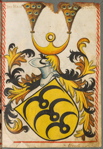  |
|
BSB Cod.icon. 392 d an armorial southern Germany, first half of the 16th century Click button marked "Miniaturansicht" above any page to view thumbnails five at a time. |
There are a handful of imperial achievements in the preface, but the real armorial starts on folio 1r. Some pages show simple escutcheons, but many include complete achievements. Four heraldic flags are pictured on folio 81v. |
|
|
BSB Cod.icon. 390 an armorial of the Holy Roman Empire made by Stephan Brechtel Nürnberg, between 1554 and 1568 Click button marked "Miniaturansicht" above any page to view thumbnails five at a time. |
The Imperial arms are on folio 21, followed over the next several pages by portraits of Kaiser Karl V and the prince-electors that include small achievements, but the real armorial starts on folio 43. Several pages on which human figures appear holding shields or large, beautifully-painted heraldic flags are interspersed among the pages giving achievements. |
  |
|
BSB Cgm 7249 register and armorial of the Augsburg canon Matthaeus Marschall of Pappenheim (1458-1541) Click button marked "Miniaturansicht" above any page to view thumbnails five at a time. |
Most of the book is organized like a family tree. An occassional escutcheon is included (usually in color, but some just sketched in) on the folios shown in images 10 through 258. In addition, several of the folios in images 278 through 315 show rows of shields held by human figures. |
 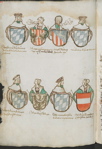 |
|
BSB Cgm 145 Konrad Grünenberg's armorial of the knights and burghers of Constanz around 1480 Click button marked "Miniaturansicht" above any page to view thumbnails five at a time. |
arms on almost every page, on plain escutcheons, in achievements, and in portraits and fanciful settings, plus some interesting livery collars, but all photographed in grayscale Image 14 shows several heraldic flags. Image 237 shows an interesting scene featuring a gallery of crests and people viewing it. Image 239 shows a group of women carrying heraldic flags and is closely followed by a couple of folios showing mounted combatants on a tourney field and then by several pages of achievements that have flag-bearing women scattered among them. |
 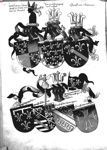 |
|
BSB Cod.icon. 309 German arms between 1475 and 1560, perhaps in southern Germany Click button marked "Miniaturansicht" above any page to view thumbnails five at a time. |
Folio 1r is long and narrow, with 32 small achievements including helms with crests and mantling painted sideways on the page. Starting on folio 2r, there are three and a half pages of simple escutcheons. Folio 4r has sixteen achievements with helms, crests, and mantling. The bulk of the rest of the book is done in a similar style, but with nine achievements per page instead of sixteen. From folio 55v through 62v the same basic layout is used but no crest or mantling has been filled in. The last three pages (starting on folio 63r) each have sixteen larger simple escutcheons in the same style as those on folios 2r through 3v. |
   |
|
BSB Cod.icon. 311 German arms the fourth quarter of the 15th century, perhaps in Augsburg Click button marked "Miniaturansicht" above any page to view thumbnails five at a time. |
The armorial starts on folio 3r. Each page has four achievements with helms, crests, and mantling. |
 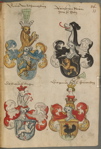 |
|
BSB Cod.icon. 312 German arms, predominantly from southern Germany southern Germany, 16th century Click button marked "Miniaturansicht" above any page to view thumbnails five at a time. |
The armorial starts on folio 1r . Almost every page has nine achievements, with helms, mantling, and crests. There are a couple of pages that have fewer, but of the same size and style. A number of pages are only partly painted. There are several places where one or two blank pages or pages of text interrupt the arms. |
 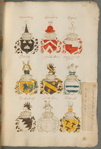 |
|
BSB Cod.icon. 312 b Paul Hector Mair's lineage book for the city of Augsburg Augsburg, around 1550 Click button marked "Miniaturansicht" above any page to view thumbnails five at a time. |
The first arms are on folio 3v. There are 133 pages each showing a dramatically-posed man with weapons and gold-chased armor near whom a shield stands balanced on its lower point with a crested helm poised on its top edge and mantling tumbling around it. There are a few text pages interrupting the arms here and there, but never for longer than a page or two at a time. |
  |
|
BSB Cod.icon. 313 Jakob Streit's register with the arms of the relatives of his Tübingen and Ingolstadt university friends and of colleagues in the Imperial Chamber Court in Speyer southern Germany, between 1560 and 1615 Click button marked "Miniaturansicht" above any page to view thumbnails five at a time. |
The arms begin on folio 1r. Almost every page has just one achievement. They are painted in a variety of styles. Many of them seem to have been cut out and pasted onto the pages. I don't know whether that's a result of conservation efforts or if it started out as a scrap book. Some of the cut-outs are badly damaged. |
 
 
  |
|
BSB Cod.icon. 318 book of the brothers of the Order of St. Hubert of Jülich/Berg Niederrhein, around 1500 Click button marked "Miniaturansicht" above any page to view thumbnails five at a time. |
The first achievement appears on folio 1r. It includes a helm, crest, and mantling and the livery chain of the order. It's followed by several pages of text. Four simpler achievements, with helms and minimal mantling, appear together on folio 5r. Starting there, a pattern emerges. Ther'es a page with four small achievements, a page that is blank or has only text, a page with one large achievement with a livery collar, and a page that is blank or has only text. Then the pattern repeats. This goes on to folio 17r, where the pattern becomes one page of four, then one page that's blank or has only text. There are a few places where this pattern is interrupted by pages that have four blank escutcheons with unpainted helms and mantling. The first couple are just one page long, but as the end of the book nears they get longer (up to five pages of blank escutcheons, with completely blank pages between). The last arms in the book are on folio 114r, and they're followed by quite a number of blanks. |
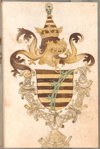  |
|
BSB Cod.icon. 320 register of Hans Lorenz of Trautskirchen and of Hans Jörg of Elrichshausen, using Abraham de Bruyn's Diversarum gentium armatura equestris Ingolstadt, between1575 and 1615 Click button marked "Miniaturansicht" above any page to view thumbnails five at a time. |
The achievements in this book are presented one on a page, mostly in elaborate printed settings. They are scattered between images of mounted male and female figures (from de Bruyn's work) and blank escutcheons in similar settings. Most include crests and mantling. Dated achievements painted in the 16th century appear on folios 1r, 8v, 16r, 23v, 25r, 28v, 29r, 36v, 36ar, 43r. Dated achievements painted in the early 17th century appear on folios 63r, 65r, 67r, and 69r. Undated achievements appear on folios 10r, 36av and 71r. Since the dated pages in the book seem to be more-or-less in chronological order, I'd guess the first two were painted before 1600. The third is the last painted page in the book, so it's hard to say when it was done. |
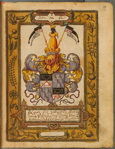 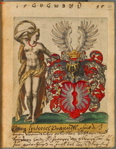 |
|
BSB Cod.icon. 326 arms of those who attended the 1594 Imperial Diet in Regensburg as participants 1594, perhaps in Regensburg Click button marked "Miniaturansicht" above any page to view thumbnails five at a time. |
From folio 1r to folio 48r, most pages show one achievement each. The style in which they are rendered and their included elements vary widely. Some have helms and crests (up to three per escutcheon), some galeros or mitres and croziers, and some simple escutcheons. There are a few places where the arms are interrupted by up to three blank pages and a few pages that have two or three escutcheons on them. |
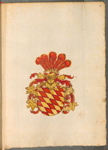 
 
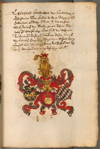 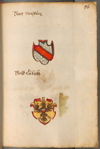 |
|
BSB Cod.icon. 326 a register of Johann Kandler of Regensburg Regensburg, betwen 1586 and 1601 Click button marked "Miniaturansicht" above any page to view thumbnails five at a time. |
There are seven achievements in this little book, the first on folio 1r. One of them is dated 1601 and one has no date; the rest are from the end of the 16th century. All include helms, crests, and mantling and have text above them (which may, at least in some cases, be mottoes, either written out or abbreviated) and text below. |
  |
|
BSB Cod.icon. 330 portraits of the Habsburg rulers of the 14th century, based on the stained glass in Königsfelden Abbey in the canton of Aargau southwest Germany, the middle of the 16th century Click button marked "Miniaturansicht" above any page to view thumbnails five at a time. |
There are 14 portraits of people kneeling on shields and nine achievements without people attached. The first arms appear on folio 1r. The achievements vary in style. Most have helms, crests, and mantling. One has a livery collar. A couple of the people are kneeling on two shields, and one is kneeling between two. One of the shields of 19v is cut in half; the rest of it is on 24r. |
  |
|
BSB Cod.icon. 391 various armorials collected in a single volume southern Germany (possibly Augsburg), around 1530 Click button marked "Miniaturansicht" above any page to view thumbnails five at a time. |
Multiple styles of emblazon are seen here. The first achievement is on folio 1r. It includes supporters. It is followed by three simple one-to-a-page escutcheons. Additional single achievements that aren't part of any larger pattern are on folios 161r, 215v, and 220v . The first two have helms, crests, and mantling. 220v has a crown, supporters, and a livery collar. Folios 3r through 34v show straight-sided, round-bottomed escutcheons four to a page. A few have crests. There's one achievement with a waisted, pointed-bottomed escutcheon, two crested helms, and mantling on folio 40r. The next two painted pages each have four similar achievements. From folio 42r to 57v there are six small achievements with waisted, pointed-bottomed escutcheons, helms, mantling, and crests on each page. On 58v and 59r there are a couple of achievements (still with helms, crests, and mantling) presented within annulets on which text is written. Folios 60v and 61r each have four achievements with waisted escutcheons, one or two helms, and mantling. Starting on folio 63r, there are several pages with one large achievement each, incorporating crowns, mitres, galeros, or helms with crests and mantling. Folio 71r has such an achievement with four small simple escutcheons around it. Folios 72v through have two achievements each. These have crosiers or helms with crests and mantling. Folios 82r through 86v have achievements with helms, crests, and mantling four to a page. Folios 87r has sixteen simple escutcheons. 87v has nine of the same size and shape, then one smaller one and one achievement including a helm, crest, and mantling. Folios 88r and 88v each have four pairs of straight-sided, round-bottomed escutcheons with a helm with crest and mantling over the sinister. Starting on folio 89r, there are again four achievements with helms, crests, and mantling per page. The style of the renderings is different from those on the earlier four-achievement pages. Folios 97r to 107v have small achievements with waisted shields, helms, crests, and mantling, mostly nine to a page. The style is different from previous achievements. There are a lot of repetitions in the arms. One-to-a-page achievements with helms, crests, and minimal mantling are on folios 109r to 127r From 128r to 150r there are two large simple escutcheons per painted page. From 151r to 154r and from 180r to 201v there are four . From 162r to 177r and 202r to 203r there are nine. And on 216r and 216v there are sixteen. Large, central achievements with helms and mantling start on folio 221r. A few of the pages also have badges or extra crests. The large achievement is accompanied by one to six smaller escutcheons or achievements on folios 238r to 241r, 262r, and 262v. A single image stretching across folios 217v and 218r shows small escutcheons in rings around the field of Bavaria. Folios 219r to 220r each show the imperial achievement flanked by rows of arms on simple escutcheons. Folio 93r and 93v show heraldic flags. Portraits of heralds in the trappings of their office balancing shields on the ground are found one to a page on folios 210r to 215r. |
 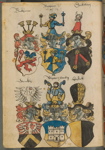
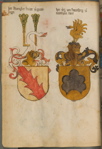 
 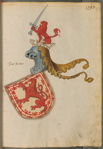
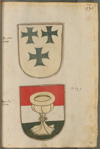   
 |
|
BSB Cod.icon. 307 a collection of arms from various (predominantly German) lands Germany, around 1600 Click button marked "Miniaturansicht" above any page to view thumbnails five at a time. |
The site doesn't list folio numbers, but the pages have numbers written on them. Most sections of the book vary too much for it to be useful to describe them, but I've tried to give myself a guide to where certain types of emblazons might be found to make the book easier to use. Several styles are repeated in multiple sections, as if several books were taken apart and the pages shuffled in. Other styles appear only in certain portions of the text. Southern German and Tirolean achievements are on pages 13 through 26. French arms (and, according to the library, the family arms of European nobility) start on page 27, four to a page on simple round-bottomed escutcheons. From the middle of page 36 through page 57 the escutcheons are mostly inverted teardrops. Pages 58 through 60 each have a large central escutcheon with four smaller ones around it, and then it's back to several round-bottomed escutcheons per page. Arms of the German nobility start on page 65. Spanish and Portuguese arms start on page 88. Page 99 has a few arms of German nobility and cities. Extracts from Haller's register start on page 100. The first few pages are achievements, many with double helms, that seem to have been cut out and pasted into the book. From 104 through 114 they're painted directly on to the page, six to a page, with helms, crests, and mantling. Then they're pasted in again starting on 115, mostly five to a page. From 155 they're drawn directly again, only four to a page, with larger helms. Family arms of southern Germany and Austria start on page 159. Arms of the electorates and authorities of the Imperial Circle of the Holy Roman Empire begin on page 203. Each page is ruled into twelve blocks and an achievement is drawn in each block. The styles in which they are drawn vary some. Most of them have helms (more than one, in many cases), crests, and mantling. There are some livery collars on page 220. On page 223-225 is the first of three pages designated by the library as "outlines of national arms". The individual escutcheons and achievements in this section vary wildly, and many are painted only partly or not at all. Painted and engraved armorial pages primarily related to the Randegg family start on page 229. The individual achievements have, again, been cut from various sources and pasted into the book. They vary a great deal. On page 234 begins a collection of family and national arms of the Holy Roman Empire. The first few pages have been ruled into twenty-four blocks. After page 239 there are twelve blocks to a page. Each block is labeled and achievements have been drawn in many (but not all) of them. They vary in their style. Most include helms, crests and mantling. After page 243 many of them have heraldic flags next to them in the block. Starting on page 245 more achievements are pasted into the book. Again, their sizes and styles and the number on each page vary considerably. There is an armored man holding a shield on page 247. There are more flags on page 258. The pedigree of the Plarer family is on pages 269_2 and 269a. Each page is divided into about 30 blocks, with one or two escutcheons per block. Some have arms and achievements drawn in and painted, some don't. Achievements of the Austrian authorities and cities begin on page 271. Most of them have been cut out and pasted into the book. Their styles and sizes vary quite a bit. Many of them have mitres and crosiers instead of helms and mantling. Arms of Tunieradels (whatever they are) start on page 296. They're painted in a style not seen elsewhere in the book, with fewer drawn-in details. Many of them have helms, crests, and mantling, but a good number are simple escutcheons. There are a few heraldic flags among them, on pages 342 and 343a. After page 344 the achievements become more varied again. On page 346-350 the achievements of commoners from München and Augsburg begin. On page 356 start the arms of commoners from Regensburg. Most are presented with helms, crests, and mantling, but some are simple escutcheons. Some are marked with 14th- or 15th-century dates--perhaps those on which the arms were granted. The styles vary considerably, and some achievements are pasted into the book. Page 404-410 starts a section of arms of princes, diocese, and noble families. Many of these appear to have been block-printed onto the page or cut out of a printed sheet, then hand colored and pasted into the book. Most of them are full achievements or simple escutcheons, many on a page. There are a few single achievements. There are also a few escutcheons with crowns, caps, or laurel chaplets instead of helms and mantling. Starting on page 444 there are a few pages of "trading cards" with portraits, arms, and dates. Commoners' arms from Augsburg start on page 450 and commoners' arms from Ingolstadt on 462. They're varied; some are pasted in. National arms and arms of the nobility of the Holy Roman Empire begin again on page 468-470. They begin with several pages of uncolored posted-in printed arms. Then there are several pages painted in the style seen in the arms of Tunieradels, above. Family arms of the nobility start on page 511. They don't seem to be finished. The arms and crests are fully painted on the first couple of pages, but the helms and mantling are barely sketched in. After that, most pages are partly-to-completely unpainted. Page 520 has pasted-in printed achievements, also uncolored. There's a sizeable number of blank pages following page 525; the armorial starts back up on 543, with an armorial pedigree of the counts, lords, and burghers of the Holy Roman Empire that takes the form of escutcheons sketched twelve to a page, almost all unpainted, some with helms, crests, and mantling. There are a few blank pages after 557. Some of the achievements are partly colored on 571 and 581. Pages 599 and 600 have painted emblazons in a new style, with crests floating above them but no helms or mantles. Starting on 601 it's back to unpainted achievements, but the style begins to vary more. Page 613 is partly painted. 614 is fully painted and has the floating crests seen earlier. There are some livery collars on 623 and 670. For several pages starting on 627, most pages have helms with crests that aren't attached to escutcheons. The last arms in the book are on page 695. |
 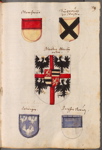
 
 
 
 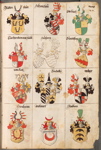
 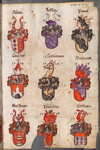
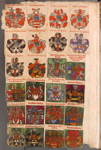 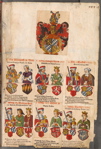
 
 |
|
Cod.icon. 333 a large armorial containing arms of Holy Roman Emperors, European noble houses, popes, cardinals, bishops, and abbots, up to the time of Emperor Rudolf II and Pope Gregory XIII southern Germany,1583 Click button marked "Miniaturansicht" above any page to view thumbnails five at a time. |
The arms in the first section of this book are painted on inverted-teardrop-shaped escutcheons with scrolling borders that were printed onto the pages in a four-by-three grid. The arms of Holy Roman Emperors start on folio 2r and the arms of royal dynasties on 5r. These escutcheons are crowned, except for those on the folio 6v, which are simple but have their borders colored yellow. (The imperial coronets differ from the others.) The arms of lesser noble houses (rulers of principalities, etc.) start on folio 7r and finish on 16r. Most of these escutcheons wear caps of maintenance, though those on folio 11r are crowned and those on 15r through 16r are simple with yellow borders. There are four sets of ecclesiastical arms under red galeros on 19r. After a few blank sheets, several pages of ecclesiastical arms with mitres (and in some cases stoles) on top follow--Spanish start on folio 21r, Italian 21v, French 24v, English 26r, Hungarian 28v, ad those from "old kingdoms" 29r. Finally we have the family arms of the popes, starting on folio 41r. Most of these escutcheons either have red galeros on top or have high domed hats on top and crossed keys behind them. On 42r they have winged cherubs' heads, cathedrals, or mounts sprouting flowers on top. Folios 47r through 49v have escutcheons in a variety of styles, most of them crowned or wearing caps of maintenance. Folios 50r through 54v are ruled into larger boxes with plain escutcheons and smaller boxes, under them, with labels. Folios 55r through 59r have waisted simple escutcheons nine to a page. One-to-a-page achievements are found on folios 60r through 122v, with the exception of folios 94v and 95r (which share a single achievement ), 97r (which has three escutcheons with a single crowned lion balanced on their tops), 99r (which is ruled with thick red lines into boxes with ecclesiastical arms with demi-angels or demi-virgins-with-child on top), 104r (which has an eagle displayed with small escutcheons scattered on it), 109v and 110r (which share a single achievement), 116r (which has two simple escutcheons and an achievement with three escutcheons sharing supporters and a single crested helm). They vary widely in their styles and included elements. Many of them have coronets, a few red or green galeros, most one to five helms with crests and mantling.. Some of these pages include death-dates for the individuals represented that are after 1600; I don't know whether the pages were painted in the 17th century or later or whether the dates were simply added in. Each painted folio numbered 124r through 134v has four achievements with helms, crests, and mantling and waisted escutcheons. 135v and 136r, 137v and 138r, and 139v and 140r show single achievements with multiple crested helms that stretch over two pages. Folio 142r shows a single ecclesiastical achievement and is followed by several pages of ecclesiastical portraits without armory, then by portraits of the prince-electors of the Holy Roman Empire with their arms, two or three to a page, starting on folio 144r. The last two painted folios in the book, numbers 150v, and 151r, each contain six achievements in a landscape orientation. Their contents vary, but most include a helm and mantling. There are livery chains on folios 47r, 60r, 77r, 82r, 100v, 102r, 102v, 111v, and 114r, supporters on 61v, 75v, 76v, 83v, 84v, 90r, 92r, 93v, 94v, 95r, 101v, 107r, 111r, 116r, 135v, 136r, 139v, 140r, and 142r, and both on 63v, 100r, and 103ar. Folios 103r and 103v each show an escutcheon with a Golden Fleece medalion pendant from it without a livery chain. There's what might be laurel on folio 65v and 77r and a motto on 101v. Cloaks appear on 63v, 111r, 111v, 112v, and 151r. |
 
 
 
 
 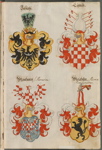
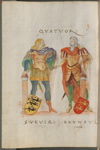  |
| Manuscript Number and Description | Notes | Representative Pages |
|---|---|---|
|
Arms of Roman Pontifs and Cardinals, Volume I: Felice III through Paul IV, and Volume II: Urban VI through cardinal Roberto de' Nobili Italy, middle of the 16th century Click button marked "Miniaturansicht" above any page to view thumbnails five at a time. |
The arms appear one to a page, on the recto side only of each folio, and are intricately painted with subtle diapering on the fields and shading that gives many charges the illusion of depth. There is nothing particularly ecclesiastical about most of the arms themselves, though they are presented surrounded by the trappings of the offices--either a mitre and crossed keys or a red galero--and labelled with their bearers' names and titles. |
  |
|
BSB Cod.icon. 268 Italy, middle of the 16th century Click button marked "Miniaturansicht" above any page to view thumbnails five at a time. |
The Roman section begins with four different escutcheons for the city itself, then the achievements of several secular and ecclesiastical leaders, usually labelled with their names and titles. Arms of individuals start on folio 31r, four to a page. No civic arms or leaders' achievements are given for Viterbo. |
  |
|
BSB Cod.icon. 269 arms of the masters of Rhodes through Father Claude de la Sengle Italy, middle of the 16th century Click button marked "Miniaturansicht" above any page to view thumbnails five at a time. |
On folio 1r there's an escutcheon with a cord around it labled "Insignia Religionis Rhodiensis". With the exception of one with a cardinal's hat, the rest of the escutcheons in the book are quartered, with the device from 1r in their 1st and 4th quarters, and are surrounded by a string of beads with crosses and a tassel on it. (It could be a rosary or paternoster beads--it certainly resembles them. And its particular form could be associated with the members of a specific order or religious institution. I just don't know.) |
  |
|
BSB Cod.icon. 270 arms from Milan, plus civic arms from other northern Italian cities, various municipalities in the Contado of Milan, and a half-dozen gates of the city of Milan Italy, middle of the 16th century Click button marked "Miniaturansicht" above any page to view thumbnails five at a time. |
The double-helmed achievement of Ioanni Iacobo Fvggero is on folio 1r. The arms of Milan are followed by the achievements of three popes and a duke, then the civic arms. The arms of individuals begin on folio 24r, four to a page, and run to the end of the volume. |
  |
|
BSB Cod.icon. 271 arms from Venice, Part I: achievements of secular and ecclesiastical leaders Italy, middle of the 16th century Click button marked "Miniaturansicht" above any page to view thumbnails five at a time. |
The double-helmed achievement of Ioanni Iacobo Fvggero is on folio 2r. Arms of popes (from Venetian families, according to the library's index) begin on folio 4r, one to a page, each with a miter and keys. Arms of cardinals (from Venetian families) begin on 7r, one to a page with red galeros and tassels. Arms of doges of Venice begin on 18r, two to a page, each with a corno ducale. Arms of bishops of Venice begin on 62r, two to a page, with green galeros and tassels. Arms of patriarchs of Venice begin on 89r, two to a page, with green galeros and tassels. |
  |
|
arms from Venice, Part II (A-IP) and Part III (IP-Z) Italy, middle of the 16th century Click button marked "Miniaturansicht" above any page to view thumbnails five at a time. |
Arms of individuals begin on folio 1r of 272, continue through the end of that volume, and start again on folio 2r of 273. |
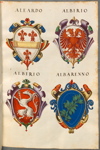  |
|
BSB Cod.icon. 274 arms from Venice,
Mantua,
Bologna,
Ancona,
Urbino,
and Perugia
Italy, middle of the 16th century Click button marked "Miniaturansicht" above any page to view thumbnails five at a time. |
The section on Venice begins with arms for the city, then the achievements of three popes. Arms of individuals begin on 5r, four to a page. The section on Mantua begins with arms for the city, then the achievements of several secular rulers, (some of which are followed by one or more pages of imprese, four to a page). The arms of individuals start on folio 120r. The section on Bologna begins with arms for the city, what seems to be an achievement for the University of Bologna, the achievements of several secular leaders of Bologna, and two popes. Arms of individuals start on folio 161r. The section on Ancona begins with arms for the city. Individual arms start on folio 215r. No civic arms are shown for Urbino. The achievements of a few secular leaders precede the usual individual arms, which begin on 247r. The section on Perugia begins with arms for the city. Arms of individuals start on folio 256r. |
  |
|
BSB Cod.icon. 275 arms from Padua, Ferrara, and Pesaro Italy, middle of the 16th century Click button marked "Miniaturansicht" above any page to view thumbnails five at a time. |
The arms of Venice appear on folio 1r. The section on Padua begins with arms for the city. Arms of individuals start on folio 3r. The section on Ferrara begins with arms for the city, then the achievements of several secular and religious leaders, the last of which is followed by three pages of imprese. Arms of individuals begin on folio 47r. The section on Pesaro begins with arms for the city, then the achievement of a duke of Urbino. Individual arms start on folio 63r. |
 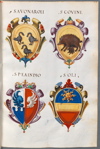 |
|
BSB Cod.icon. 276 Italy, middle of the 16th century Click button marked "Miniaturansicht" above any page to view thumbnails five at a time. |
Each city's section begins with its arms, then proceeds directly to individual arms, four to a page. |
  |
|
BSB Cod.icon. 277 arms from Florence Italy, middle of the 16th century Click button marked "Miniaturansicht" above any page to view thumbnails five at a time. |
Florence is represented by a large fleur-de-lys Florencée on folio 1r. The achievements of a few popes and dukes of Florence follow. Individual arms start on folio 9r. |
  |
|
BSB Cod.icon. 278 arms from Lucca, Siena, Pisa, Pistoia, Volterra, Arezzo, Cortona, and Sansepolcro Italy, middle of the 16th century Click button marked "Miniaturansicht" above any page to view thumbnails five at a time. |
The section on Lucca begins with two sets of arms for the city, then the achievements of a pope and a duke of Lucca. Individual arms start on folio 5r. The section on Siena begins with arms for the city and the achievements of three popes, followed by an unlabeled achievement showing the arms of the third pope displayed with a crown. The arms of individuals start on folio 32r. The section on Pisa begins with arms for the city and the achievement of one pope. Individual arms start on 71r. The section on Pistoia begins with arms for the city. An ape wearing a kerchief is clinging to the back of the escutcheon; I'm not sure if it's a crest, a supporter, or what. Arms of individuals start on folio 100r. The sections on Volterra, Arezzo, Cortona, and Sansepolcro each begin with the arms of the city, then proceed directly to individual arms. |
  |
|
BSB Cod.icon. 279 Italy, middle of the 16th century Click button marked "Miniaturansicht" above any page to view thumbnails five at a time. |
The section on Naples begins with arms for the city, achievements of two popes, eight cardinals, and a variety of secular leaders. The arms of individuals start on folio 27r. The section on Genoa begins with arms for the city, arms labeled "LIBERTAS", and the achievements of six popes, a prince, eight cardinals, and four dukes of Urbino. The arms of individuals start on folio 99r. |
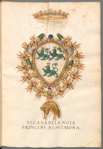  |
|
BSB Cod.icon. 280 arms of French knights of the order of St. Michael Italy, middle of the 16th century Click button marked "Miniaturansicht" above any page to view thumbnails five at a time. |
Each painted page in this volume contains one set of arms on a large escutcheon. Most of them are surrounded by the livery collar of the order and have coronets above them. The forms of the coronets seem to vary with the rank of the bearer, with that of Kaiser Karl V, on folio 1r, being the most elaborate. There is one section of the book, from folio 47r to folio 59r, in which they have red galeros, instead; the captions indicate the bearers of these arms are cardinals. |
  |
| Manuscript Number and Description | Notes | Representative Pages |
|---|---|---|
|
BSB Cod.icon. 285 a Book of the Golden Fleece the Netherlands, near the end of the 16th century Click button marked "Miniaturansicht" above any page to view thumbnails five at a time. |
The first arms in the book are those of the founder of the order, Philip the Good, on 2v. His achievement, like those of subsequent order principals, takes up a full page and is followed by a portrait of him in the order's regalia. The achievements of the other members of the order are presented at about a quarter the size. They all include crests and the livery collar of the order. Most pages (aside from those with the principals' arms) contain four achievements. Some have two achievements and a block of text and a few are all text or are blank. There aren't more than two or three blank pages in a row before the end of the book, where there are quite a few. |
  |
|
BSB Cod.icon. 286 names and arms of the knights of the Golden Fleece 1560, perhaps in Italy Click button marked "Miniaturansicht" above any page to view thumbnails five at a time. |
The first arms in the book are those of the founder of the order, Philip the Good, on folio 2. His achievement, like those of the other order principals, is alone on the page and slightly larger than the achievements of the other members (which are seen up to six on a page, usually with some text). All the escutcheons are accompanied by helms with crests; some of the marshalled arms have up to three each. |
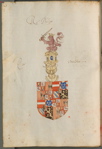  |
|
BL MS Stowe 594 William Bruges's Garter Book southeast England (probably London) around1430 to1440 Thumbnails on the index page (to which a link is given above) only. |
Folio 5v shows St. George with a sword in his hand and a dragon at his feet. He carries a shield with his attributed arms on it, and the Garter King (principal officer of arms of the order) kneels nearby wearing a heraldic tabard. Folios 7v through 20r each show a knight wearing a heraldic tabard and, over that, a floor-length cloak on the left shoulder of which the badge of the order is displayed. His name is written on a scroll above his head, and with his right hand he supports a framed panel on which are painted the arms of successors to his stall in St. George's chapel in Windsor Castle. |
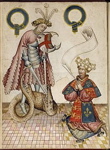 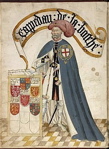 |
This page was written and is maintained by Coblaith Muimnech, who owns the copyright to the text. Please do not reproduce any portion of it without express consent.
Click to visit Coblaith's homepage or the index to her heraldry articles.
Know of other armorials that should be included? Share the details!
http://www.kb.nl/bladerboek/wapenboek/browse/book.html
http://daten.digitale-sammlungen.de/bsb00043104/image_10